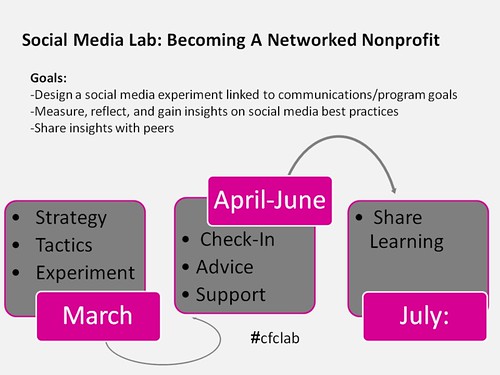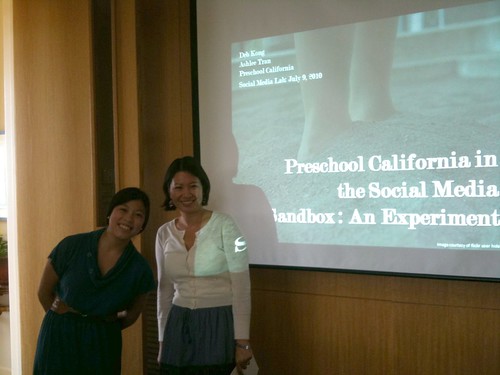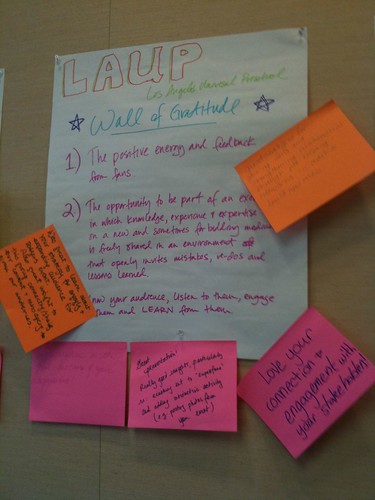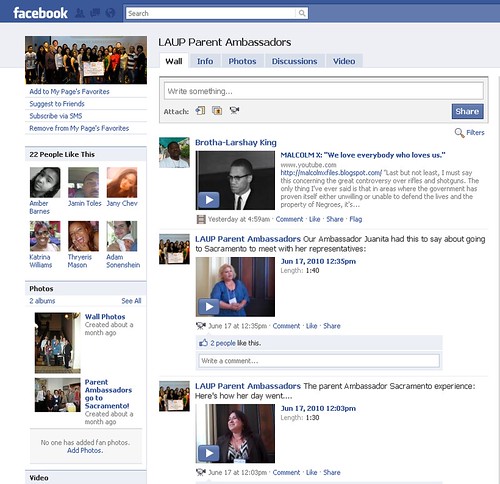As Visiting Scholar in Nonprofits and Social Media at the David and Lucile Packard Foundation, I am coaching grantee organizations and leading workshops and peer trainings on how to become a Networked Nonprofit. It is a fantastic laboratory to take some of the ideas in the book and put in them into a practice.
One of the themes in the book, The Networked Nonprofit, is the importance of doing experiments. They do not frame them as success or failure but as learning. The problem is that many nonprofits approach social media with over blown expectations, don’t realize them, and then throw their hands up and quit. So, I designed and have been testing a training program that embraces thoughtful do-it-yourself social media experiments and a peer learning process for sharing the learning.
The inspiration was part The Lab Theater, a place where you try out experimental works before you bring them to the main stage. There is also a social learning component. Think about those 4th grade science experiments where huddled over your experiment you all learn together. The instruction not only included the content – all the best practices and how-tos, but also took an approach that encouraged and developed reflection.

Last week, we had the final session of the “Social Media Lab,” a social media peer group training with a small group of grantees from the Children, Families, Communities Program, that was launched a few months ago. I was incredibly lucky to have a fantastic group of participants, all passionate about their work, very knowledgeable, and excited about integrating social media into their programs or communications plans. I also was honored to work side-by-side with esteemed colleagues Shiree Teng and Cheryl Contee.

Participant-Generated Instructional Content
The best part of this design is that participants are the content – the community is the curriculum! The program includes two face-to-face workshops. The first workshop delivers content about becoming a Networked Nonprofit as well as tips and tactics on social media implementation and an “experiment in a box.” We also included a lot of hands-on lab time.
Participants go off and work on their experiments. We used a wiki and conference calls to check in as a group. There was also one-on-one coaching. I approached my instructional role – less as expert and more as network weaver and technology steward – a helpful guide on the side. The final session puts the participants on the stage to share their learnings – either through ignite style presentations or speed geeking.
Treating participants as adult learners – allowing them to take responsibility for their learning and being the experts – produces quite a rich experience. I was amazed to see how far participants had come from a few months ago.
Sharing Insights Around Practice

You can dig deeper into the details over at the wiki as each participant shared a one-page “lab report.” The experiments were very focused initial forays into social media. They were all amazing. But the biggest value as participants noted is that having to prepare a report or presentation about what they did helped consolidate their learning and insights.
Here’s quick sampling:

LA Universal Preschool. This was a Facebook experiment incorporated as part of the outreach for the 2nd Annual LAUP Dodger Day, an event that brings staff, providers and families throughout Los Angeles County together for a day to celebrate the “graduation” of preschoolers. LAUP has a group of parent ambassadors who serve as their key advocates in Sacramento or on land. They established a fan page for this group so they can be their advocates on Facebook as well. LAUP also discovered that they by providing engaging content on Facebook other super fans will self-identify. PreSchool California
PreSchool California: Did an experiment using Twitter as a way to connect with journalists. With the media landscape shifting from print to online, Preschool California has adjusted its strategy to ensure it is reaching its target audiences through both traditional forms of media and the rapidly growing social media. PreSchool California was able to connect initially with journalists covering their issue. They discovered that Tweets are more informal, less time consuming than email so journalists may be more likely to read. They discovered a slight disconnect between those journalists that wrote print stories on early learning issues, and those education journalists that were on Twitter. Despite only having a few interactions with reporters, Preschool California retweeted and commented on a number of articles, garnering responses from other advocates, which helped increase their issue exposure to a larger audience. They discovered that Twitter has value as a listening channel to support their overall communications strategy.
Fowler Hoffman did a listening experiment to identify who was participating in conversations on social media platforms about two issue areas – summer learning and after-school – listen to what they are saying about the issues, and engage them in conversations on these platforms.
“Tweeting to the Choir” Alone May Not be Sufficient: They discovered a small group of advocates and organizations with a similar focus and looked for ways to engage with those who are not already involved. They discovered there are many people and organizations who are sharing information and engaging in dialog about their same issues and topics but just not in the same way. At first this was a little uncomfortable to outside the existing circle of known allies by @responding to people they didn’t know. But they did an experiment by sharing useful links to summer learning study with moms who were talking about summer learning for their kids. These tweets ended up getting retweeted by these moms and they were able to attract more fans.
Children Now and Partnership for Children and Youth explored how to begin to integrate social media content channels into their newly designed web sites. Both ended their experiments with insights about how to set up systems and structures for content creation across channels, linking, and engaging.
Advancement Project set up a Facebook presence for one of its programs, Healthy Cities as a proof of concept for understanding the work flow of integrating content and engaging with fans. They will use the lessons learned to share with the education program to set up its Facebook presence as the next experiment. The intent is to use the lessons learned to get other staff buy in other departments.
United Ways of California focused on using Facebook to communicate and facilitate networking between staff members of United Ways in California. Several of the organizations participating in the lab observed that it was hard for them to envision using social media because “they don’t touch the public.” Not only do many of their UW members have an organizational presence on Facebook, many staffers us it personally. Setting up a Fan Page is an efficient way to share professional information. This experiment focused on using metrics to evaluate how engaging content was and recruitment tactics.
The Yolo County Children’s Alliance’s (YCCA)/Children’s Health Initiative’s (CHI) experiment was to start a blog for Certified Application Assistors (CAAs). Like the United Ways of California, YCCA’s does not touch the grassroots and the big ah ha for them was they could use social media to support their interactions with different constituents and for the purposes of sharing professional learning.
HCAP is a small agency and its executive director participated. As she notes in her case study, “The world of social media was quite new to our organization. Due to this learning curve, we felt it best to take one step at a time so that we have a better understanding of how it is used both in the personal social world, as well as business, and non-profit world.” They did a listening experiment designed to better advance their understanding of social media and its role in their communications strategy. This is a critical first step towards a social culture for many nonprofits that is often skipped and it is terrific to have a case study.
An Unanticipated Outcome

One of the unanticipated outcomes was the rich discussion we had after everyone shared their case studies. The group realized that there were a lot of opportunities and ways that they could support one another’s work through social media. And, that it didn’t required a huge amount of extra work.
Celebrating Learning
At the end of the session, each participant received a gift – The Networked Nonprofit book and a Networked Nonprofit T-shirt created by the good folks at NTEN!
